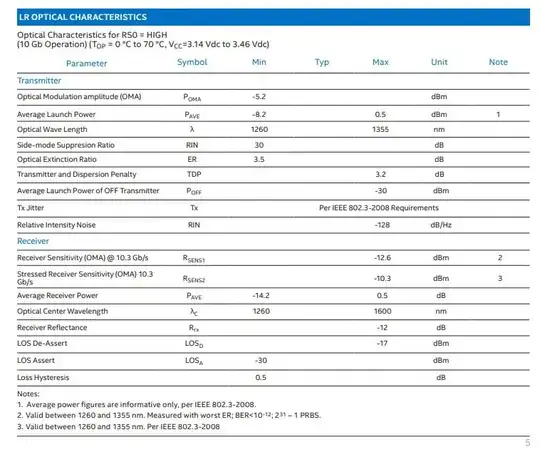This picture is a part of the Intel E10GSFPLR (SFP+, Long Reach) datasheet. Can I use them in a short link (less than 1 meter) without any attenuator? Which numbers are important in this datasheet to pay attention to? (To make sure that these SFP+ do not damage without attenuator in short links scenarios)

2 Answers
Most 10 km PHYs can talk to each other even over very short links.
The key is whether the max launch power overshoots the max receive power, effectively blinding the receiver.
With this transceiver, the max launch power and the max receive power are both .5 dBm, so no additional attenuation is necessary. Additionally, the average lauch power, -8 dBm, is far below the max receive power, so you're really on the safe side.
With higher powered transceivers and short links, running on the upper edge of receive power (when average launch power ≈ max receive power) can reduce the lifetime considerably, but that isn't the case here.
As a side note, the -LR doesn't mean "long reach" but the -L stands for long wavelength (~1300 nm) and the -R for 64b/66b PCS large block code. See this question for more details.
- 81,287
- 3
- 67
- 131
-
Actually it does... S, L, and E are short, long, and extended range. – alex.forencich Apr 22 '21 at 01:05
-
@alex.forencich That isn't correct. E.g. 10GBASE-LX4 is short range but using ~1300 nm wavelengths. You should check out IEEE 802.3 Clause [edited] 1.4 *Definitions*. – Zac67 Apr 22 '21 at 05:54
-
That clause doesn't exist, but apparently there is a list in 30.5.1.1.2. Interesting that it has nothing to do with range as per the spec. I have definitely seen 1310 nm transceivers marked 10GBASE-ER, I suppose those are not marked correctly then. – alex.forencich Apr 22 '21 at 06:42
-
For example https://www.fs.com/products/48813.html – alex.forencich Apr 22 '21 at 06:45
-
Oh, actually looking at 30.5.1.1.2, the 25G, 40G, and 100G variants are all listed as multimode, long reach, and extended reach. So it seems like the spec itself is not consistent. – alex.forencich Apr 22 '21 at 06:49
-
@alex.forencich Of course, -ER is "extended" reach, but the -E stands for 1500 nm lambda and the -R for 64b/66b PCS code. Dunno where I got Clause 3.1.2.3 from, it's actually in Clause 1.4 *Definitions*. The wavelength is often related to the reach but not always - 10GBASE-LX4 = ~1300 nm, 8b/10b, 4-lane WDM with *short* reach over MMF or 10 km over SMF. – Zac67 Apr 22 '21 at 07:24
-
The spec is not particularly clear on the meaning of the letters. Both 100GBASE-LR4 and 100GBASE-ER4 are defined in clause 88, but there is no mention of 1550 nm, only 1310 nm CWDM, and different reaches. – alex.forencich Apr 22 '21 at 07:36
-
... and in Clause 1.2.3 *Physical Layer and media notation*, e.g. "1000BASE-SX: 1000BASE-X using short wavelength laser devices over multimode fiber" or "10GBASE-LRM: IEEE 802.3 Physical Layer specification for 10 Gb/s using 10GBASE-R encoding and long wavelength optics for multimode fiber". – Zac67 Apr 22 '21 at 07:36
-
I think the only conclusion we can draw here is that the spec doesn't explicitly spell out the precise meaning of the letters, and it also doesn't use them consistently (with LR4 and ER4 both being 1310 nm CWDM but with different reaches, instead of ER4 being 1550 nm WDM) – alex.forencich Apr 22 '21 at 07:59
-
1Agreed - at least -E optics aren't entirely consistent. – Zac67 Apr 22 '21 at 08:31
-
1I just checked the spec, and 10GBASE-LX4 is 10km range on single mode fiber, same as 10GBASE-LR – Peter Green Mar 31 '23 at 11:14
Launch power max 0.5 dBm, receive power max 0.5 dBm. Should be fine. Also, -8.2 to 0.5 dBm is a huge range for launch power, although this may be specified with aging in mind (launch power reduces with module age, starting closer to 0 dBm and ending up closer to -8 after some number of years of continuous use).
Also, if you have too much signal in an optical fiber, you can add some attenuation by wrapping it around a pen (or other thin round object) a few times, more wraps and tighter wraps for more attenuation.
- 493
- 4
- 8